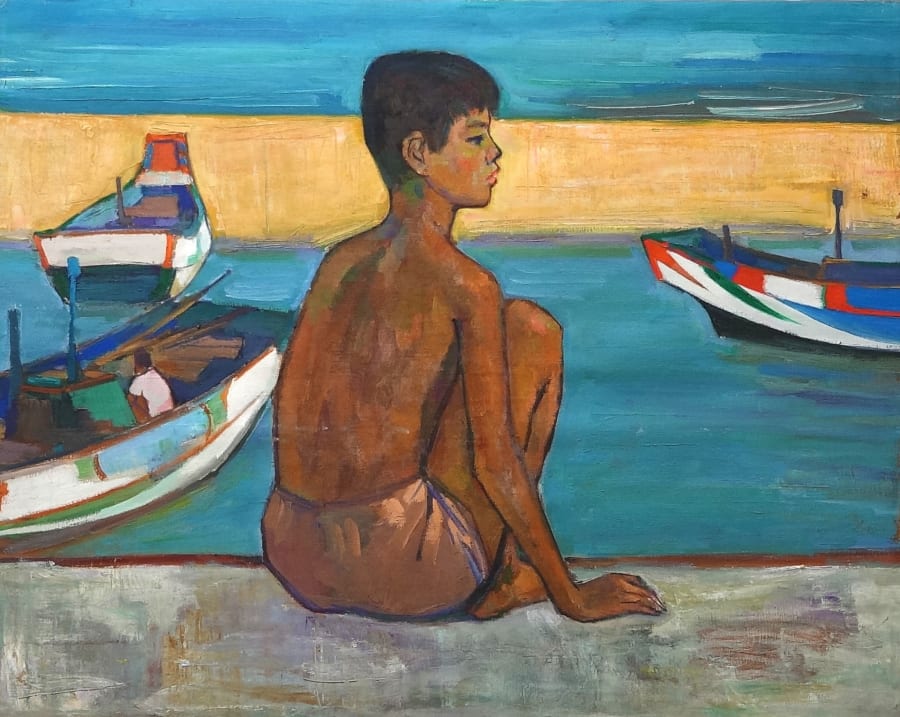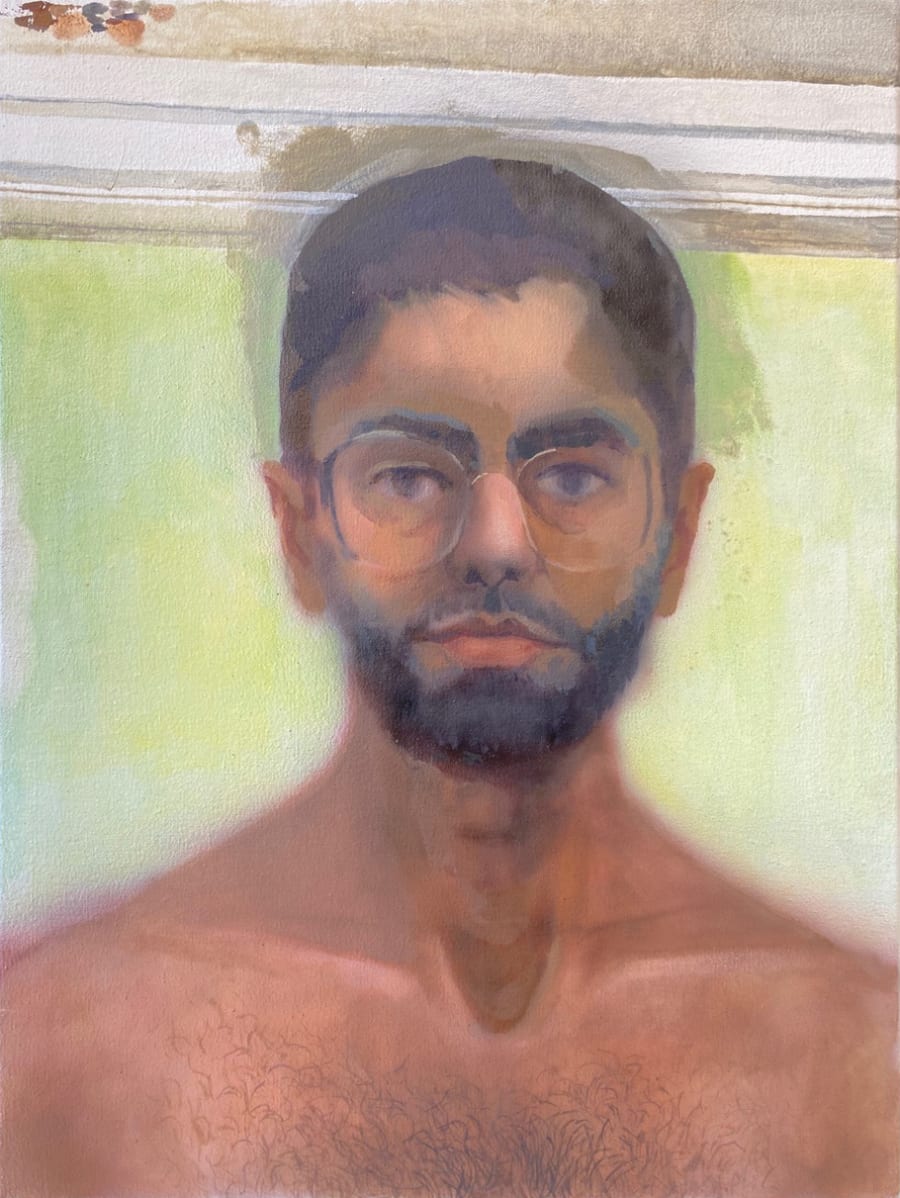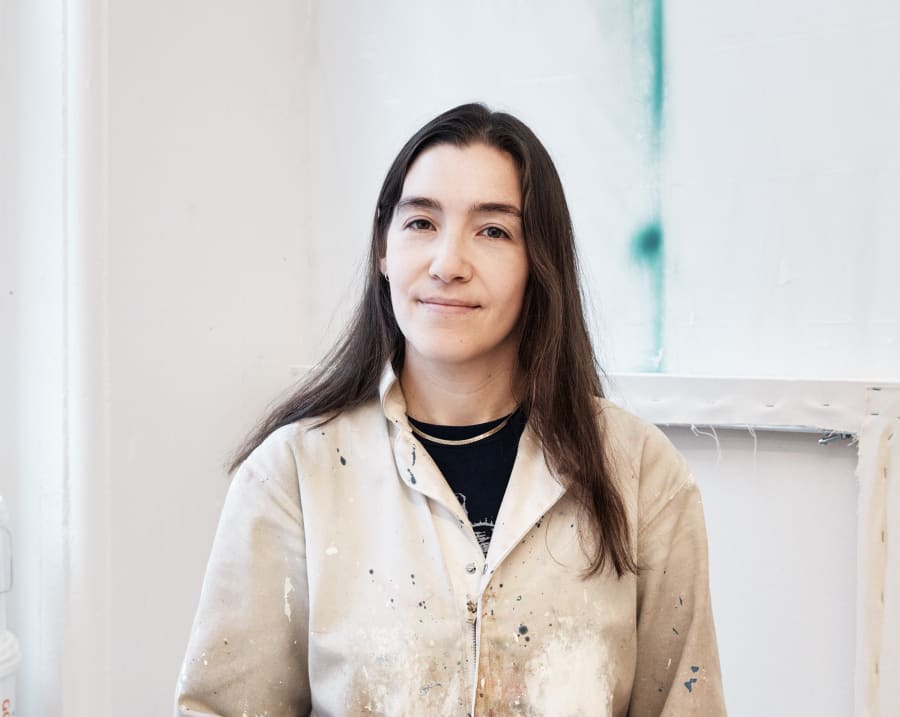A lounging young man. A teddy bear staring at a landscape. A human figure surrounded by conifers. The evocative scene of a woman sitting on a chair, rendered coolly. These paintings are by four up and coming artists born in Japan in the 1980s: Daisuke Fukunaga, Ulala Imai, Shota Nakamura, and Yu Nishimura, respectively.
The people in their paintings sleep. Sometimes, they eat or work. Inanimate dolls and food items are imbued with inner life. Alluding to dreams, these ethereal paintings hover between fantasy and the everyday – that overused but useful word for all that is overlooked or cast aside.
Ulala Imai’s bright, diaristic paintings are closely cropped and contain commonplace and pop cultural objects in different settings. They generally deal with two subjects – food and stuffed animals, anthropomorphized through scale in both domestic and outdoor settings, such as LOST (2023), where a robed teddy bear stands in a marshy landscape. The still-life paintings, which Imai makes in a corner of the home she shares with four other family members, give viewers a sense of her simple yet eclectic taste for different fruits and desserts, Marimekko fabrics, Arabia cups and saucers, thickly sliced and buttered white toast, avocado, and popular characters like Darth Vader, Chewbacca, and Snoopy.
In Japan, mascots, or ‘loose characters,’ are iconic, neutral figures that accompany nearly every product and service. They take the edge off social relations, which are often very formalized. The characters in Imai’s paintings seem to replace humans and screen out any familial drama. Food items and characters alike are painted with admirable efficiency and a minimum of deftly applied strokes, building up to slightly out-of-focus images.
Imai cites Édouard Manet’s asparagus paintings, also written about in Marcel Proust’s In Search of Lost Time, as an inspiration. Imai’s works, however, are optimistic and devoid of obvious commentary; the food paintings are often characterized in the local press as ‘delicious.’ Toast, bananas, pineapples, peaches, and even hot dogs refer to the good life. They are soft celebrations of how delightful – and, paradoxically, multilayered – simple pleasures can be.
The paintings of Yu Nishimura (who is also Imai’s partner and a fellow graduate of the Tama Art University in Tokyo) are sentimental, but chillier. While Imai’s work stages dolls as if they could be alive, Nishimura’s paintings are populated by simply, wispily rendered characters that appear a bit like those in manga and anime, albeit with blanker expressions. Typically, a single, slightly angled line indicates the nose, and the eyes are high set, as in Neon Girl (2021) and Playback (2020). A tiny mouth close to the chin is suggested by another line. Nishimura’s palette is usually subdued and alternately cool or autumnal. Combined with a blurring effect created by smearing the paint, it gives the works a melancholic tone.
Nishimura’s out-of-focus, manga-fied slices of life seem to not refer to reality. They appear like pictures of memories, designed to evoke the quotidian while remaining unspecific enough to spark feeling in all. Some of the paintings are composed with a double-exposure effect – the outline of a walking figure laid over buildings as in town scape (2022), and in under the umbrella (2022), a figure holding an umbrella is superimposed on a close-up of a man’s face as snow falls around them. The filmic scenes read as representations of afterimages burned into the psyche, but their psychic effects remain opaque. Nishimura’s images are slightly wan, but mostly detached in mood.
Blasé attitude, a ‘metropolitan psychic phenomenon’ as sociologist Georg Simmel put it, characterizes Nishimura and Imai’s paintings. That both of them are children of the 1980s may partially explain their tone. In that postmodern decade, city pop, a synth-driven, self-consciously urban and emotionally distant genre of pop music, produced hits on Japanese airwaves and influenced many. Pop cultural phenomena that blend Western and Eastern influences such as city pop continue to impact the archipelago’s creatives.
In recent Japanese slang, emo-i – a word derived from the post-hardcore music genre known as emo – means nostalgic rather than emotive. Berlin-based Shota Nakamura’s paintings, most often set in the woods, can be described as emo-i. Originally from Yamanashi Prefecture, home to Mt. Fuji, Nakamura’s relation to nature as represented in his works seems essentially nostalgic and romantic. In night drawing (2022), a man draws in a notebook at night, at the foot of a winding road in the sparsely wooded outdoors. The bottom half of Nakamura’s day napping (2022) shows a man sleeping under a patchwork quilt. A flower in a vase sits on the floor. Above, trees circumscribe a lake with a sailboat floating on it. In both paintings, there is no apparent boundary between interior and exterior space.
In a very short time, Nakamura’s paintings have become less illustrative and dramatically more painterly. The influence of European Modernist painters is also now stronger. In subject matter, paint application, and expressive use of color, Les Nabis artist Pierre Bonnard and Impressionist Suzanne Valadon come to mind; and in palette, Nakamura emulates Neo-Expressionist Per Kirkeby’s spectrum of warm colors, such as browns and reds. Men’s bodies were also more playfully shown in the earlier paintings – two men sleeping together naked outdoors in sleepers (2021), or a man sleeping alone in a meadow wearing a shirt but no trousers or underpants in A sleeping guy in the meadow (2021). The sexual charge of the earlier paintings – these men, who sleep, walk, and pee in the woods, are they cruising? – is now absent; figures in the more recent paintings are simply restful. Similarly to his aforementioned peers, Nakamura seems to foreground a certain emotional distance.
Tokyo-based Daisuke Fukunaga’s paintings also self-consciously reference European Modernists and frequently depict figures taking respite. In Dance (carriers) (2022), six figures romp around each other, mediated by wheeled luggage carriers. The figures’ eyes are closed, either in somnambulance or overcome by pleasurable concentration. It is a clever reworking of Henri Matisse’s La Danse II (1910) in subject and arrangement. In Fukunaga’s version, the dancers have been recast as workers. Short brushstrokes of thinly applied paint create a shimmering effect.
Fukunaga’s ambivalence regarding European Modernism, as well as labor, is most humorously conveyed in Crawler in the City (2020), a self-portrait of the artist imagined as a Google Maps surveyor. A smartphone in each hand, wearing a backpack equipped with a 360-degree camera, the leisurely flâneur of 19th-century Paris has been contemporized as an artist who must also hold a part-time job. In Beautiful work (2022), an aproned woman strikes a pose while meeting our gaze as she puts on a yellow rubber glove to clean a bathroom. Behind her sits a colorful bouquet of dusters and cleaning supplies. In Fukunaga’s Night work (2020), a similar bouquet of jellyfish-like mops luminesces.
Daydream (2020), Under the fragrant olive (2020), and Vague time (2022) all contain uniformed and booted workers in repose, often with their helmets removed, posed like odalisques. In Vague time, a figure in bright red work pants and a matching top reclines outdoors. The sun is setting. A uniformed guard stands by a portable toilet in the background. In front of the resting figure there is an empty helmet and some open scaffolding clamps. The effect is empathetic and generous, as Fukunaga frees this worker, unfettered at last. It is a fantasy for sure, but one worth having in a time when workers’ wages have long failed to keep up with inflation.
Fukunaga, Imai, Nakamura, and Nishimura’s paintings are stylized, but not particularly expressive of anything obviously interior or personal. As such, the works distance themselves from – or even renounce – the sort of emotional intensity or political positioning often expected of artists working in the West. They hold their punches, delivering instead emotional effects that are deliberately hard to pin down. They are romantic yet cool, sentimental but distant, familiar but also unnameable. And it is in this ambivalence that the works are most dreamlike.
Daisuke Fukunaga is represented by Tomio Koyama Gallery (Tokyo) and Nonaka-Hill (Los Angeles).
Ulala Imai is represented by Xavier Hufkens (Brussels), Karma (Los Angeles, New York), Nonaka-Hill (Los Angeles, Kyoto).
Shota Nakamura is represented by Clearing (New York, Brussels, Los Angeles).
Yu Nishimura is represented by Crèvecoeur (Paris).
Taro Nettleton is Associate Professor of Art History, Temple University Japan Campus.
Published on February 16, 2024.
Top image: Daisuke Fukunaga, Under the fragrant olive (detail), 2020. Courtesy of the artist and Tomio Koyama Gallery.


